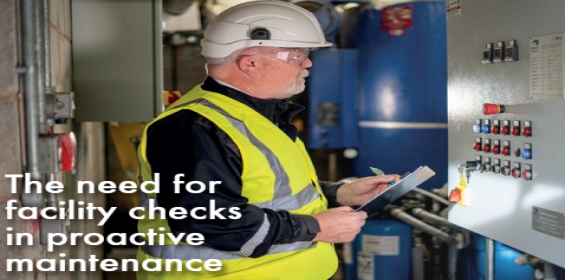The need for facility checks in proactive maintenance
Published: 15 January, 2024
Dave Dyer, technical sales engineer at thermal fluid specialist Global Heat Transfer, explains how manufacturers can make changes around the facility to improve the productivity of their heat transfer system and better prepare for incidents that could lead to health and safety risks or costly downtime.
Our environment has a significant impact on how we work. According to a study by the Staples Corporation, 94% of workers surveyed reported feeling more productive in a clean workspace. Businesses often want a clean space because it can reduce sick days, increase motivation and reduce stress, but did you know it can also improve equipment performance in manufacturing facilities?
Proactive maintenance is vital when operating a heat transfer system. Regular maintenance of the equipment, as well as regular fluid sampling as part of a preventative maintenance programme enables manufacturers to monitor performance and fluid condition and prepare for maintenance before it leads to downtime.
While system and fluid maintenance are integral to productivity, manufacturers might still find that the system and thermal oil have a shorter lifespan than expected. In these situations, manufacturers might find that performance is impacted by conditions outside of the system.
So, how can the choices you make around the facility impact productivity?
Housekeeping
A clean, organised working environment can both aid productivity and keep workers safe, so facilities managers should consider how they can improve general housekeeping of heat transfer systems. Taking steps to clear pathways and remove electric cables and rubbish, for example, are quick ways to reduce trip hazards on site.
When working with dangerous and flammable substances, such as thermal fluid, manufacturers should pay close attention to any oil outside of the system. Any spillages should be cleaned up immediately — while a smaller spillage might not directly impact production, leaving it unattended can increase the risk of slips and trips as well as fires.
Equipment needs
Over time, parts of the heat transfer system will begin to wear, reducing overall efficiency. While manufacturers might concentrate on proactively maintaining core components of the system, they should also prepare for when that part breaks down. Unplanned downtime stops production and increases operational costs, so manufacturers should have spare parts on site to reduce any production losses. Keeping critical spares on site, such as pump cartridges, parts for the heater or burner and spare fluid for topping up the system, can be integral to maintaining production.
Signage
To remain compliant with health and safety regulations and pass safety audits, manufacturers must have clear signage across the facility about safety procedures. Labelling flammable and high voltage areas and other hazards is important when using heat transfer oils.
Facilities managers can also introduce signage across the facility to improve maintenance procedures. Correctly labelling fluid ensures that old and new fluids are not confused when topping up the system — adding old fluid into a new barrel will result in more waste. Manufacturers should also add signage to the system indicating the direction of oil flow.
In an emergency
We all know the saying “fail to prepare, prepare to fail”. Despite this, we often find that manufacturers have not adequately prepared for some emergency scenarios. While risk assessments may outline the probability of some of these issues occurring, facilities managers and health and safety managers should consider how they can better prepare for serious issues and ensure they are aware of who is best to call in each potential scenario.
Manufacturers should ask themselves what they would do if certain scenarios occur, such as the fluid going off low level, the heater stopping or the pump failing. Most importantly, manufacturers should consider how the facility would respond to major incidents. Having this plan in place is critical to protecting staff and reducing damage. Similarly, management teams must consider how to stop production quickly when issues occur. While many facilities have an emergency stop button, it is often located on or near the system. Placing the button far away from the system, in another room, by the door or by an exit, means that engineers can safely cease production while evacuating.
Storage
Where do you keep your thermal oil? To save on space, manufacturers can store oil outside, but leaving barrels to the elements can negatively impact the quality of the oil. For example, if rainwater sits on top of barrels or intermediate bulk containers (IBCs) and then the air temperature heats up, the barrel or IBC expands. Once it cools down, the container contracts, syphoning water from the top, rendering the new oil unusable, even if completely capped and sealed.
Similarly, when replacing oil, manufacturers should take care to clearly label waste oil and new oil, keeping them separate in the facility. Mislabelling could cause problems further down the line, such as topping up a system with old waste oil.
Making improvements
Investing time and effort in preventative maintenance can improve site safety, increase productivity and reduce costs for manufacturers. Educating staff, both existing and new, on the importance of safety measures such as signage and housekeeping, as well as best practices like good oil storage and emergency planning, is integral part to heat transfer maintenance. Taking these steps is integral to regulatory compliance. For example, to comply with UKEX (formally known as ATEX 137) Regulations, manufacturers must follow best practice to ensure the safety of the site, monitor fluid to manage risk and train staff to effectively operate and maintain the system.
Just like a cluttered office can cause stress and reduce a team member’s ability to concentrate, a disorganised manufacturing facility can negatively impact machine performance. By including facility checks in proactive maintenance, facilities managers can extend the lifespan of their heat transfer system and better prepare for incidents that could lead to health and safety risks or costly downtime.
https://twitter.com/G_HeatTransfer
https://www.linkedin.com/company/heattransferfluid/







